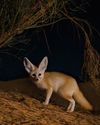THE SEA OF LIFE
BBC Wildlife
|June 2021
As we celebrate United Nations World Ocean Day on 8 June, our knowledge of the power and fragility of our oceans still has a long way to go.

I can see the sea!” my brother and I would shout out in unison as we crested the hill at Mariakani, one of the coastal settlements overlooking the port of Mombasa, where the East African coast meets the Indian Ocean. It was that first glimpse of the sea that marked the end of a long journey, and the start of our family holiday.
The journey began in Nairobi, and always before dawn. Our cherry-red Datsun 120Y would be loaded up with bags and sandwiches, headlights on, engine running and my dad, drawing on the first of many cigarettes, would wait impatiently for his bleary-eyed brood to get ready.
This was the early 80s. Kenya, with its post-colonial borders shaping a new national identity, was a young country and we were a young family on a trip to the seaside. The draw was the Indian Ocean. I can still remember how the smell and feel of the air changed as we left the high-altitude city of Nairobi, with its cool, dry atmosphere giving way to the dusty, hot savannah air that, in turn, slowly became warm, humid and salty as we made our gradual descent to the coast.
What I didn’t know then, which I do now, is that on that journey my senses were awakened to an ancient and invisible dance. Powered by the sun, this is a molecular exchange where energy, minerals, nutrients and water are perpetually cycled between the ocean, land, air and all living things. Known respectively as the hydrosphere, geosphere, atmosphere and biosphere, the reality is these realms have no real boundaries and, in the past 30 years or so, scientists studying this ‘dance’ have come to view the Earth as a single system, in which the ocean plays a major part.
This story is from the June 2021 edition of BBC Wildlife.
Subscribe to Magzter GOLD to access thousands of curated premium stories, and 10,000+ magazines and newspapers.
Already a subscriber? Sign In
MORE STORIES FROM BBC Wildlife

BBC Wildlife
"I was terrified the elephant would ram us"
African elephant in Kenya
2 mins
January 2026

BBC Wildlife
ALL YOU EVER NEEDED TO KNOW ABOUT THE Fennec fox
THE FENNEC FOX IS THE SMALLEST fox in the world, with a body length that can be as little as 24cm.
3 mins
January 2026

BBC Wildlife
INTO THE PLASTISPHERE
A unique synthetic ecosystem is evolving in our oceans – welcome to the plastisphere
7 mins
January 2026

BBC Wildlife
“More than half of all animal life exists in a parasitic relationship, and all life lives in symbiosis”
Our survival depends on species evolving to live together - but some relationships take dark turns
7 mins
January 2026

BBC Wildlife
Are animals able to dream?
SLEEP IS A MYSTERIOUS THING. FOR A long time, we weren't sure why we do it.
1 mins
January 2026

BBC Wildlife
Does a cuckoo know it's a cuckoo?
ABSURD LITTLE BIRDS ACROSS THE world lay their eggs in the nests of other species, leaving the hapless parents to raise a changeling at the expense of their own offspring.
2 mins
January 2026

BBC Wildlife
Orcas killing young sharks
Juvenile great whites are easy prey for orca pod
1 mins
January 2026

BBC Wildlife
Ocean goes on tour
Acclaimed film touring the UK, backed by live orchestra and choir
1 min
January 2026

BBC Wildlife
Feisty bats hunt like lions
Winged mammals use a 'hang and wait' strategy to take down large prey
1 mins
January 2026

BBC Wildlife
SNAP-CHAT
Richard Birchett on magical merlins, wily coyotes and charging deer
2 mins
January 2026
Translate
Change font size

